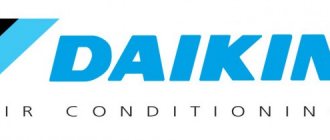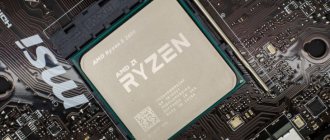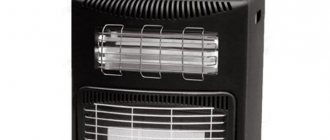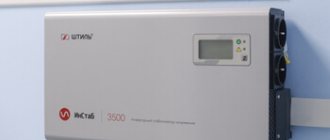When choosing suitable equipment for heating a house or cottage, you should pay attention to inverter-type equipment. The operating principle of such devices is based on the conversion of alternating current to bring them to the required parameters.
Among the differences of an inverter heater are efficiency, low noise level and a small range of temperature fluctuations in the room.
The characteristics of the equipment are superior to infrared and water heating. And before buying, you should get acquainted with the selection criteria and the most popular models.
Criteria for choosing an inverter heater
A gas appliance is more profitable, but more dangerous to operate
The first thing people pay attention to when choosing inverter heaters is power. Productivity is calculated using different formulas. The first is the same as for a conventional heating radiator.
It is assumed that for heating 1 sq. m, 100 W of power is enough. For a 10-meter room you need a 1 kW device, for 20 sq. m – 2 kW. The second method of calculation is by volume.
First, the number of cubic meters is determined, then it is multiplied by the appropriate coefficient. For reinforced concrete panel houses it is 41 W/cubic meter. m. for the rest - 34 W per cubic meter. m.
When choosing an inverter type air conditioner, the main criteria are:
- Manufacturer. The Toshiba and Mitsubishi brands belong to the premium class. Timberk – to medium. Ballu and Electrolux - to the budget segment.
- Energy carrier – electricity or gas. Electric models are most often chosen. A gas appliance is more profitable, but more dangerous to operate.
- Energy consumption. Mitsubishi brand models are characterized by high energy consumption. Toshiba products are considered the most energy efficient.
- Availability of a serial number on the device. This is also a sign of quality technology.
Buyers of equipment should check the availability of certificates and marks of conformity. Products that meet international standards and are safe for health must have such documents and symbols. You can find certificates on the websites of consumer electronics stores.
Comparison of an inverter system with heating using an electric boiler
What conclusion can be drawn after six months of operation:
- The heating system based on Electrolux inverter convectors is a complete home heating system. It can automatically regulate the temperature and is convenient to control, including remotely.
- The inverter system is much cheaper in terms of equipment and installation costs.
- The inverter system is much more economical. According to research by the Moscow Energy Institute, such savings reach 40%. This is explained by the high inertia of the heating system according to the “boiler-radiator” scheme while maintaining a given temperature.
- System reliability. If one element of the inverter system breaks down, the house will not freeze, which cannot be said about the heating system on the boiler. If the boiler or pump fails, the entire heating system of the house will stop working. And it is not always possible to quickly solve a problem without the help of a specialist.
- Aesthetics: no white polypropylene pipes on the walls, space saving - no boiler room needed.
In the video below: Research by the Moscow Energy Institute comparing the energy consumption of a heating system using electric convectors with inverter control and a heating system “electric boiler + water radiators”.
Toshiba RAS-07EKV-EE/RAS-07EAV-EE – quality and reliability
Installation of an inverter air conditioner from the EKV model range will provide heat to rooms up to 20 square meters. m. The design of the model allows it to look good in any interior. The low level of noise generated during operation does not interfere even at night.
To improve ease of maintenance, the instrument panel is made smooth. And the operation of both the indoor and outdoor units is almost silent. The noise level in the serviced premises does not exceed 26 dB.
Other features of the model include a self-cleaning tray and several operating modes. An economical air conditioner consumes no more than 200 W, a normal air conditioner consumes 550 W. There is the possibility of automatic start, operation in drying mode, turbo mode for fast heating or cooling.
Another useful option is a timer that turns equipment on or off at a given time. Information about the operation of the equipment is displayed on the LCD screen, simplifying management.
List of advantages of energy-saving equipment:
- quiet operation of external and internal units;
- ease of use – even an inexperienced user can figure out the settings;
- remembering user-specified settings;
- anti-ice system, which allows you to turn on the equipment even at low outside temperatures.
Flaws:
- length of communications (10 m), which may not be enough for installation in some rooms;
- a price that exceeds the costs of other heaters of similar power.
Why is it economical
Inverter heaters are considered one of the most cost-effective devices. How does this manifest itself? Let's start with the fact that such systems, having reached the required temperature level, do not completely turn off. The device continues to operate, reducing the speed to a minimum. This process leads to maintaining a comfortable and favorable climate in the room. At the same time, the heater does not waste extra electricity turning it on and off.
In addition, inverter heaters do not use “high current” for starting during their use. This is also beneficial for consumers. When starting the unit, the current does not exceed the rated current. And this has a positive effect on the service life of such devices. In this case, the device is not constantly in the on and off mode. Such cycles significantly reduce the life of the equipment. It is worth noting that, unlike conventional heating devices, inverter heaters can save up to 40% of electricity.
Timberk TEC.E0 M 2000 – environmental friendliness and safety
The main task of the TEC.E0 M 2000 convector is to heat rooms up to 15-20 square meters. m. Such equipment is worth buying both for use in an apartment, and for a summer house or office. Operational safety is ensured by the presence of a protective sensor.
In addition, the design of the device allows for both wall mounting and floor installation. The kit includes parts for two options - brackets and support legs. You can select the optimal mode using a convenient regulator. The first stage provides a power of 1.2 kW, the second – 2 kW.
Features of the technology include the Heating Energy Balance technology used. It increases the environmental friendliness of using the device and provides instant heating. Acceptable microclimatic conditions will be obtained in just 30-60 minutes after turning on the device.
Other reasons for purchasing include the device’s resistance to voltage surges, light weight, and lack of noise during operation or shutdown. The latter feature allows the device to be used for heating living rooms, including a bedroom or children's room.
Advantages of the technique:
- quiet operation;
- installation on the floor and mounting on the walls;
- lightness – the device weighs only 5 kg;
- compactness – the heater does not take up much space;
- availability of power adjustment;
- reliability of fall protection;
- heating rate.
Disadvantages of the device:
- drying the air during work;
- the length of the cord, due to which the equipment will have to be placed close to the outlet;
- lack of wheels on the legs to move the device.
Operating rules
The devices should be located no closer than 50 cm from the furniture.
Recommendations for using heaters extend their service life. The rules are simple:
- Do not install the heating device next to furniture or a wall - no closer than 50 cm;
- It is not recommended to leave the heater on all night - this can only be done if it is equipped with a thermostat that determines the operating and shutdown times;
- Heaters must not be placed under a window opening;
- It is prohibited to dry things on them.
In case of problems of any kind, you must turn off the device and contact a service center.
Daikin FTXB35C/RXB35C – power, quietness, functionality
At first glance, the Daikin electric inverter heater does not look like a powerful and functional piece of equipment. However, this is precisely what a device it is. The productivity is enough to service an apartment with a living area of about 30-36 square meters. m.
The model is also suitable for a house of the same size, cottage or office. The possibilities include not only heating, but also cooling, ventilation, and dehumidification. The outside temperature is practically irrelevant for operation. It can be within –15 – +43 degrees.
The list of equipment functions includes turbo cooling, delayed switching on or off, comfortable sleep mode, and cleaning.
The device effectively cleans the air flow using a titanium apatite filter. The work can be controlled from the remote control, which has its own screen and antibacterial coating. The service life of the device is more than 20 years, the life of the control device is only 2 times less.
Equipment advantages:
- power that is enough to heat 1-2 rooms in a house, apartment or country house;
- increased length of communications (15 m);
- interior design that can fit well into any room;
- matte surface without unnecessary details, which is easier to wipe;
- functionality – the presence of a self-diagnosis and ventilation mode;
- memorable settings;
- build quality.
Minuses:
- quite high price;
- lack of remote control backlighting – an option found on cheaper models.
Electrolux ECH/AG2-1500 T – economical, long service life
The efficiency of the Electrolux heater is ensured by a powerful heating element, the length of which is increased by 10; due to the updated design.
The device has high heat dissipation and an impressive service life. The operating life of the heating element alone is at least 25 years. This is more than inverter heaters from other manufacturers with a similar price.
Uninterrupted operation of the equipment is ensured by built-in thermal protection. Because of this, the possibility of overheating is excluded. And when the maximum temperature is reached, the convector turns off automatically.
Another feature is the front panel that does not heat up during operation. While the Air Gate BIO filtration system effectively purifies the air. Its set of filters includes elements for removing tobacco smoke and protecting against viruses.
Reasons for purchasing equipment:
- efficiency of work;
- build quality;
- silent operation - during operation the sound of the relay is almost inaudible;
- filtration in the form of a plastic mesh;
- wheels on legs for convenient movement of the device.
Disadvantages of the technique:
- heating rate;
- bulky legs - although this feature provides stability to the device;
- lack of a handle with which to carry the heater.
What is
Inverter heaters are able to control the heating process automatically. So, for example, when the set air temperature is reached, the system does not turn off, as in other devices, but switches to a reduced power level. Due to this operating principle, it is possible to maintain the desired level of heat in the room. The heater consumes much less energy, since there is no need to constantly turn the device on and off.
The operating principle of an inverter heater is similar to that of an air conditioner. The main working part in it is a heat pump, the basis of which is the internal and external units. The first contains a heat exchanger, inside of which freon accumulates under high pressure. Freon temperature can reach 80 degrees. After this, it enters the external unit, where lower pressure is observed. Here freon is transformed from liquid to gaseous state. As a result of its transition, a large amount of thermal energy is released.
An inverter heater is very efficient. Even if the room is very cold, the device begins to intensively heat it without reducing its efficiency.
Main characteristics
The operating life of inverter heaters is longer due to the absence of peak loads.
The installation converts the incoming alternating current into direct current, and then again converts the direct current into alternating current, but with different characteristics. As a result, the device does not work with mains electricity, but with current with improved performance. This prevents damage to the device during power surges: the heater lasts longer and operates with greater efficiency.
The work scheme is also changing. A conventional heater, when turned on, heats the air to a specified temperature, and when reached, turns off completely. When the sensor signals a decrease in the temperature in the room, the device turns on again. However, starting the device causes a short-term peak load. This mode contributes to rapid wear of parts.
An inverter heater for a home works differently. When turned on, the heater heats the air to the specified temperature, but after reaching it it does not turn off, but reduces the operating power to 5–10%. When the temperature drops below the marked value, the heater increases power.
In this mode, the power gradually increases and decreases, and there are no peak loads. The temperature also changes more smoothly, which allows you to increase shutdown time and reduce electricity consumption.
How does an inverter heating boiler work?
As a rule, if we consider classic electric boilers, then the principle of operation is that energy is transferred to the coolant using a heating element. So, if the design has a heating element, then it is also necessary to provide a separate place to heat the water, protect the heating element from the corrosion process, and also take into account heat loss.
Inverter (or induction) heating boilers operate on the principle of electromagnetic induction.
Thus, with the help of an alternating magnetic field, an induction current is generated. In order for this process to be implemented, direct current from the electrical network must be converted into alternating current. This is what the inverter does - it can work both from the network and from batteries.
So, an inverter heating boiler has two circuits:
- Magnetic. Generates an alternating magnetic field.
- Heat exchanger. Heats up the coolant.
When alternating current is applied, the coil creates a magnetic field, which heats the water in the pipe system.
Use in heating systems
Today, this device is used in heating systems where the power source is electrical energy, less often gas supply. It can be implemented wherever there is electricity. To use inverter heating, you do not need permits, and installation does not require approval from the relevant services. This device is much cheaper than others. A gas boiler can be easily replaced with an inverter heater.










